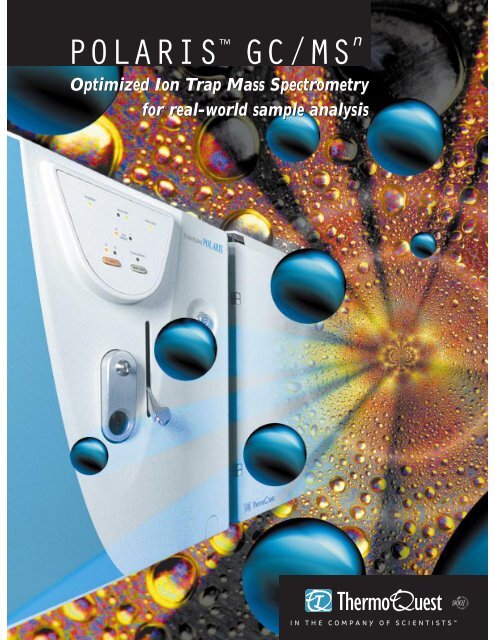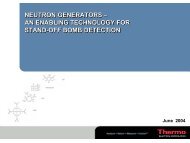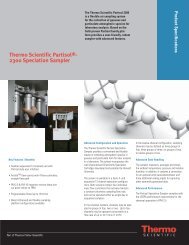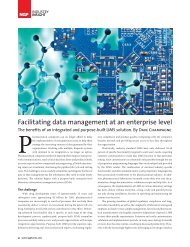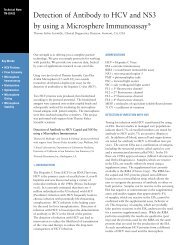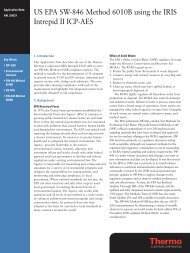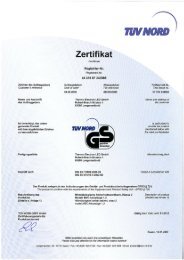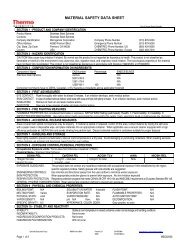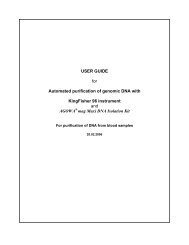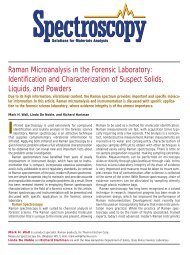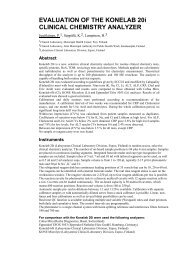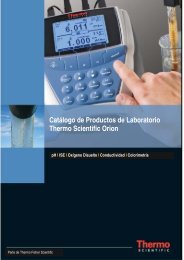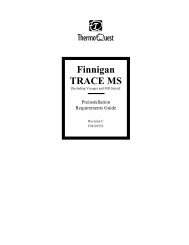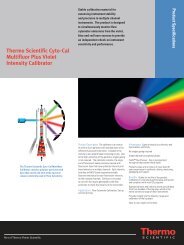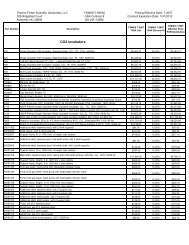POLARIS GC/MS
POLARIS GC/MS
POLARIS GC/MS
Create successful ePaper yourself
Turn your PDF publications into a flip-book with our unique Google optimized e-Paper software.
<strong>POLARIS</strong> <strong>GC</strong>/<strong>MS</strong> n<br />
Optimized Ion Trap Mass Spectrometry<br />
for real-world sample analysis
<strong>POLARIS</strong> <strong>GC</strong>/<strong>MS</strong> n<br />
Introducing ion trap mass spectrometry<br />
The Finnigan Polaris is the latest ion<br />
trap mass spectrometer for gas<br />
chromatographic detection. It is<br />
especially designed for the benchtop<br />
market requirements among which are<br />
ruggedness, reliability, high sample<br />
throughput, and ease of use and<br />
maintenance. The commercial ion<br />
trap detector was introduced by<br />
Finnigan in the 1980’s and enhanced<br />
in the 1990’s with the addition of<br />
features such as <strong>MS</strong>/<strong>MS</strong> and negative<br />
ion chemical ionization. Now with<br />
Polaris, a chromatographer can have<br />
the power of simultaneous full scan EI<br />
and <strong>MS</strong>/<strong>MS</strong> available at the click<br />
of a mouse in one versatile, affordable<br />
instrument. The system features:<br />
New TRACE <strong>GC</strong><br />
• Electronic flow/pressure control<br />
• Column characterization for<br />
retention time matching<br />
New Xcalibur Software<br />
• Common platform for ThermoQuest<br />
<strong>GC</strong>/<strong>MS</strong>, LC and LC/<strong>MS</strong> systems<br />
• Merlin Report Writer for<br />
customizable, automated reporting<br />
New High Temperature<br />
Ion Source<br />
• Fully customer-tested for<br />
ruggedness and reliability<br />
• Supports EI, <strong>MS</strong>/<strong>MS</strong>, CI and<br />
probe analysis in all modes<br />
Benzophenone<br />
10 ng test mix<br />
Xcalibur's Merlin Report Writer gives the analyst complete flexibility and simplicity for<br />
fully automated, customizable reports.<br />
1<br />
2<br />
Polaris, with its new ion source, is designed for high throughput of the most difficult sample matrices.<br />
With a source temperature of 250ºC contamination is minimized. Hundreds of samples can be analyzed<br />
between routine source maintenance.<br />
3<br />
4<br />
1 Removable ionization volume<br />
2 Long-life filament<br />
3 High temperature ion source<br />
4 Ion trap mass analyzer
Full scan EI ANALYSIS key applications: • Industrial<br />
• Environmental<br />
• Residue<br />
Industrial Alcohols<br />
100<br />
100<br />
50<br />
0<br />
0<br />
s s<br />
TIC<br />
1.8 2.0 2.2 2.4 2.6 2.8 3.0 3.2 3.4 3.6 3.8 4.0 4.2 4.4 4.6 4.8 5.0 5.2<br />
Time (min)<br />
100<br />
80<br />
60<br />
40<br />
20<br />
0<br />
Full Scan<br />
EI/<strong>MS</strong><br />
41.1<br />
43.1<br />
39.1 45.1<br />
55.1<br />
59.0<br />
73.0<br />
Full scan analysis gives the analyst complete confidence, with NIST library identification<br />
and superior quantitation.<br />
3.43<br />
3.52<br />
3.66<br />
40 50 60 70 80 90 100 110 120 130 140 150<br />
m/z<br />
40 50<br />
55 58<br />
57<br />
50 53 60<br />
60<br />
3.77<br />
69.1 74.1 85.1<br />
84.1 87.1 101.1<br />
Industrial raw materials such as alcohols and ketones can be analyzed without the presence of<br />
ion-molecule reactions which typically cause misidentification by all other ion traps.<br />
Validated compound identification<br />
NIST library<br />
confirmation<br />
36 39<br />
4143<br />
42 45<br />
44<br />
59<br />
67 69 71 74<br />
70<br />
73<br />
80<br />
83<br />
85<br />
87<br />
OH<br />
3.91<br />
3.99<br />
101<br />
90 100<br />
2-methyl-3-pentanol<br />
2-methyl-3-pentanol<br />
110<br />
Ion trap detectors are well known for<br />
their superb sensitivity in the full scan<br />
mode. The analyzer acts similar to an<br />
absorption trap in that the target<br />
analyte concentration builds up over<br />
time (milliseconds) until the<br />
population of ions fills the detector to<br />
capacity. The ions are then expelled<br />
into the electron multiplier for<br />
identification and quantitation.<br />
In this way the ion signal is much<br />
stronger than other types of<br />
mass spectrometers.<br />
In addition to the obvious sensitivity<br />
increase, ion traps also have superb<br />
selectivity for removing unwanted<br />
background interferences. Ion trap<br />
detectors have the ability to select<br />
which ion masses are trapped by the<br />
detector and which ions are allowed to<br />
pass through and not be counted. All<br />
of the storage capacity of the detector<br />
is optimized for the target analytes<br />
and not the matrix. This is especially<br />
useful when measuring PCBs or<br />
dioxins in sludge, drugs in biological<br />
fluids, pesticide residues in fruits and<br />
vegetables, and other difficult<br />
applications.
New Finnigan Polaris <strong>GC</strong>/<strong>MS</strong>/<strong>MS</strong> ultimate selectivity for target analytes<br />
Ion trap <strong>GC</strong>/<strong>MS</strong>/<strong>MS</strong> is the most<br />
powerful chromatography technique a<br />
scientist can utilize. <strong>MS</strong>/<strong>MS</strong> is quite<br />
simply this:<br />
A molecule is ionized in the normal<br />
manner and the ions are sent into the<br />
ion trap. The ion trap is tuned to a<br />
single ion mode in which a preselected<br />
(parent) ion is captured and<br />
all other ions are allowed to pass<br />
through the detector. The parent ion<br />
is now energized within the ion trap<br />
to dissociate it into a spectrum of<br />
product ions. These unique product<br />
ions are free from chemical<br />
interference, which allows for extreme<br />
sensitivity and detectivity in<br />
complicated matrices.<br />
High throughput is necessary in<br />
today’s laboratory environment.<br />
Difficult analyses are not exempt<br />
from this requirement. Determination<br />
of pesticides in food, endocrine<br />
disrupters or dioxins in the<br />
environment, drugs in biological fluids<br />
and many others are all applications<br />
that can be performed routinely and<br />
accurately with <strong>GC</strong>/<strong>MS</strong>/<strong>MS</strong>.<br />
Triazolam – Tricyclic Antidepressant<br />
100<br />
0<br />
150<br />
100<br />
203.1<br />
238.1<br />
279.1<br />
316.1<br />
342.0<br />
207.1 239.1 281.1<br />
177.2<br />
240.1 307.1<br />
343.9<br />
176.1<br />
253.1<br />
317.1<br />
163.1<br />
202.1 237.1<br />
267.1<br />
282.2<br />
341.1<br />
344.9<br />
361.1<br />
386.0<br />
0<br />
200 250 300 350 400<br />
m/z<br />
313.1 277.1<br />
100<br />
315.1<br />
100<br />
0<br />
150<br />
313.1<br />
200 250 300 350 400<br />
m/z<br />
16.0 16.5 17.0 17.5 18.0 18.5 19.0 19.5 20.0 20.5 21.0 21.5 22.0<br />
100<br />
80<br />
60<br />
40<br />
20<br />
0<br />
(a)<br />
19.92<br />
20.01<br />
20.23<br />
0<br />
150<br />
174.1<br />
242.2<br />
243.2<br />
278.1<br />
201.2<br />
214.2 251.2 286.2<br />
313.1<br />
313.8<br />
200 250 300 350 400<br />
m/z<br />
The process of <strong>MS</strong>/<strong>MS</strong> involves (a) ionization of the compound of interest; (b) isolation of a single ion; and<br />
(c) dissociation of the isolated ion into its product ions. This process increases the selectivity of the analysis by<br />
removing the matrix from the product ions.<br />
Pesticides in Orange Extract – Matrix Removal<br />
Full Scan<br />
EI/<strong>MS</strong><br />
<strong>MS</strong>/<strong>MS</strong> Chromatogram<br />
<strong>MS</strong>/<strong>MS</strong> of Fensulfothion<br />
(parent ion - m/z 293)<br />
156.0<br />
158.1<br />
(b)<br />
Time (min)<br />
21.33<br />
21.35<br />
100 120 140 160 180 200 220 240 260 280<br />
m/ z<br />
Isolation<br />
Ionization Dissociation<br />
The selectivity of <strong>MS</strong>/<strong>MS</strong> analysis is far superior to full scan EI or SIM. This allows the chromatographer to<br />
achieve lower detection limits and unambiguous compound identification in the most difficult matrices.<br />
19.91<br />
217.9<br />
236.0<br />
237.0<br />
(c)<br />
263.9<br />
265.0<br />
265.9<br />
293.0<br />
300
100<br />
0<br />
100<br />
0<br />
Full scan<br />
EI/<strong>MS</strong><br />
6.7 3<br />
7.57<br />
8.03<br />
6 7 8 9 1 0 1 1<br />
Time (min)<br />
9.30<br />
1 0. 05<br />
1 0.46<br />
6.30 7.1 9 7.7 5<br />
8.4 0<br />
8.9 2<br />
9.86<br />
1 0.54 1 1.06<br />
<strong>MS</strong>/<strong>MS</strong><br />
9.1 4<br />
<strong>POLARIS</strong><br />
Collect full scan and <strong>MS</strong>/<strong>MS</strong> data simultaneously<br />
9.30<br />
Mevinphos<br />
Mevinphos<br />
(parent ion - m/z 192)<br />
1 0. 06<br />
9 .58 1 0.39<br />
1 1.05<br />
8 0 1 0 0 1 2 0 1 4 0 1 6 0 1 8 0 2 0 0<br />
Simultaneous full scan and <strong>MS</strong>/<strong>MS</strong> allows accurate quantitative and qualitative analysis of target compounds<br />
and unknown compounds.<br />
10 0<br />
0<br />
100<br />
0<br />
Full scan<br />
EI/<strong>MS</strong><br />
109.1<br />
127.0<br />
m / z<br />
1 6 4 .1<br />
1 9 2.1<br />
78.9 160.1 19 2.8<br />
85. 1 99.0<br />
110.1<br />
149. 1<br />
164.8<br />
194.1<br />
<strong>MS</strong>/<strong>MS</strong><br />
10 2.1<br />
109.1<br />
11 3. 0<br />
127.0<br />
13 5 .1<br />
14 9 .1<br />
1 5 9.9<br />
1 6 4.0<br />
1 6 4.8<br />
key applications:<br />
• Arson<br />
• Pesticide residue<br />
• Sports testing<br />
<strong>GC</strong>/<strong>MS</strong>/<strong>MS</strong> is a target analysis<br />
technique, so you must know what<br />
you are looking for in the sample.<br />
However, full scan EI/<strong>MS</strong> analysis<br />
allows the chromatographer to<br />
measure any compound that might be<br />
present in the sample provided that<br />
the concentration is sufficient and the<br />
matrix is not too intense in that part<br />
of the chromatogram. As you can well<br />
imagine a combination of full scan and<br />
<strong>MS</strong>/<strong>MS</strong> would be very powerful. The<br />
full scan chromatogram can be used to<br />
identify and quantitate compounds<br />
that are not on the target analyte list,<br />
while the <strong>MS</strong>/<strong>MS</strong> chromatogram<br />
provides very accurate low level<br />
quantitation for the selected analytes.<br />
Our new Xcalibur software gives the<br />
analyst the ability to collect full scan<br />
and <strong>MS</strong>/<strong>MS</strong> data simultaneously. How<br />
is this possible? Polaris combines its<br />
rapid scan speed with the powerful<br />
Xcalibur software which collects and<br />
separates the data appropriately.<br />
Quantitative and qualitative analysis is<br />
both accurate and reliable. This<br />
reduces analysis time, enhances data<br />
quality and maximizes productivity.
Chemical IONIZATION key applications: • Explosives<br />
• MW determination<br />
• Toxicology<br />
Chemical Ionization has always been<br />
an important feature of mass<br />
spectrometry. A significant percent of<br />
the spectra in the standard library<br />
database do not have a molecular ion<br />
present. Clearly this means there is a<br />
strong probability that many of the<br />
compounds tested for in routine or<br />
research laboratories will not show a<br />
molecular ion in the spectrum. By<br />
providing molecular weight<br />
information, positive ion chemical<br />
ionization (PICI) naturally becomes<br />
important in compound identification.<br />
Traditional M+1, M+29, and M+41<br />
adduct ions with methane reagent gas<br />
are invaluable in determining the<br />
molecular weight of a compound.<br />
Negative ion chemical ionization<br />
(NICI) is a very selective and sensitive<br />
tool for determining compounds that<br />
are electronegative such as PCBs,<br />
dioxins, chlorinated pesticides, and<br />
derivatized drugs. Only those<br />
compounds that are electronegative<br />
will respond to any extent and<br />
produce quantities of negative ions.<br />
This makes NICI very selective when<br />
confronted with a difficult matrix.<br />
In combination with <strong>MS</strong>/<strong>MS</strong>, highly<br />
halogenated compounds can be<br />
accurately measured at femtogram<br />
levels with consistent library matching<br />
in the most challenging matrices.<br />
PICI Mode – Analgesic/Narcotics<br />
100<br />
9.44<br />
0<br />
8.0 8.2 8.4 8.6 8.8 9.0 9.2 9.4 9.6 9.8 10.0 10.2 10.4 10.6 10.8 11.0<br />
Time (min)<br />
100<br />
80<br />
60<br />
40<br />
20<br />
0<br />
100<br />
174.1<br />
202.1<br />
172.1 218.1<br />
220.1<br />
150 160 170 180 190 200 210 220 230 240 250 260 270 280 290 300<br />
m/z<br />
0<br />
8.2 8.4 8.6 8.8 9.0 9.2<br />
Time (min)<br />
9.4 9.6 9.8 10.0 10.2<br />
100<br />
80<br />
60<br />
40<br />
20<br />
0<br />
Methane CI<br />
Positive ion chemical ionization, complete with confirmatory adduct ions, is a powerful complementary<br />
tool for toxicological analysis.<br />
NICI Mode – Explosives<br />
Negative CI<br />
9.10<br />
9.02<br />
197.0<br />
The selectivity and sensitivity of negative ion (electron capture) chemical ionization is useful for testing<br />
compounds such as explosives, derivatized drugs, dioxins, and PCBs.<br />
210.0<br />
181.0 211.0<br />
167.0 198.0<br />
137.1 209.0<br />
Meperidine - MW 247<br />
(Demerol)<br />
232.0<br />
246.0<br />
248.0<br />
Trinitrotoluene - MW 227<br />
(TNT)<br />
249.0<br />
276.0<br />
M+41<br />
288.2<br />
120 130 140 150 160 170 180 190 200 210 220 230 240 250 260 270 280 290 300<br />
m/z<br />
226.8<br />
M+1<br />
M+29<br />
CH 3<br />
0 2 N NO 2<br />
NO 2
Direct Probe ANALYSIS key applications: • Research<br />
• Chemical synthesis<br />
• Natural products<br />
Direct Insertion – Antibiotics<br />
100<br />
95<br />
90<br />
85<br />
80<br />
75<br />
70<br />
65<br />
60<br />
55<br />
50<br />
45<br />
40<br />
35<br />
30<br />
25<br />
20<br />
15<br />
10<br />
5<br />
0<br />
98.2<br />
116.1<br />
123.2<br />
132.1<br />
158.2<br />
174.1<br />
(M) Erythromycin - MW 733<br />
176.1<br />
365.1<br />
383.1<br />
179.1 557.3 648.3<br />
715.3<br />
221.1 307.2 334.2<br />
490.2<br />
522.2 660.3<br />
239.1 289.2 384.1<br />
411.0 464.3 574.3<br />
495.2 602.3<br />
644.4 661.4 716.4<br />
100 150 200 250 300 350 400 450 500 550 600 650 700 750<br />
m/z<br />
Direct probe analysis combined with <strong>MS</strong>/<strong>MS</strong> can quickly determine the presence of a drug, carcinogen,<br />
endocrine disrupter, or priority pollutant in any matrix without the need for sample preparation or<br />
chromatography.<br />
HO<br />
HO<br />
O<br />
472.2<br />
OH<br />
O O<br />
O<br />
N<br />
OH<br />
558.3<br />
Interchangeable probes for non-<strong>GC</strong> applications<br />
O<br />
O<br />
O<br />
OH<br />
O<br />
Direct Exposure – DEP<br />
Direct Insertion – DIP<br />
Direct probe mass spectrometry is an<br />
alternative sampling technique when<br />
the sample material cannot pass<br />
through a capillary <strong>GC</strong> column.<br />
Some examples include sugars, long<br />
chain amino acids, small proteins and<br />
triglycerides. The spectrum of these<br />
compounds can be obtained by placing<br />
the sample onto a probe tip and<br />
inserting the probe directly into the<br />
mass spectrometer.<br />
The direct sample probe can also be<br />
used as a screening tool when<br />
combined with <strong>MS</strong>/<strong>MS</strong>. A complex<br />
sample such as soil, blood, hair or<br />
other biological material can be placed<br />
directly onto the probe. By using<br />
<strong>MS</strong>/<strong>MS</strong>, the presence or absence of<br />
particular target analytes can be<br />
determined. This efficient technique<br />
eliminates tedious sample preparation<br />
and gas chromatographic analysis,<br />
saving cycle time and money.<br />
Finnigan Polaris offers the<br />
chromatographer a wealth<br />
of fast, powerful and reliable<br />
solutions. Come join us in<br />
the company of scientists –<br />
you’ll see the difference<br />
in your data.
System configuration<br />
Polaris includes the TRACE <strong>GC</strong>* with Digital<br />
Pressure and Flow Control (DPFC); analyzer with EI<br />
source and full scan EI, SIM, <strong>MS</strong>/<strong>MS</strong> and <strong>MS</strong> n modes.<br />
PC data system † has a minimum of Pentium II 400<br />
MHz processor, 64 MB SDRAM, 6.4 GB hard drive,<br />
32X CD-ROM, 17” SVGA monitor and Xcalibur<br />
software for full instrument control, data acquisition and<br />
fully automated data processing and customized report<br />
generation.<br />
Options/Accessories<br />
Autosampling<br />
AS2000 liquid* or HS2000 headspace* autosampler.<br />
Other sampling accessories available.<br />
Sample introduction<br />
Direct Sample Probe system with interchangeable direct<br />
insertion or direct exposure probes.<br />
TRACE <strong>GC</strong><br />
Second detector installed including FID, ECD or NPD.<br />
Programmable Temperature Vaporizer (PTV) for split,<br />
cold split, splitless and large volume injection (LVI) with<br />
digital pressure and flow control (DPFC). Cold<br />
on-column injector with large volume injection and<br />
software optimization.<br />
Polaris <strong>MS</strong> detector<br />
Open-split or jet separator interface for Megabore<br />
columns.<br />
Vacuum interlock system.<br />
Turbomolecular pump (230 L/sec).<br />
External Ionization CI mode for PICI and<br />
NICI (ECD-<strong>MS</strong>) applications.<br />
Xcalibur Data System<br />
NIST library<br />
Wiley library<br />
Pfleger-Mauer-Weber library<br />
Finnigan pesticide library<br />
*Comprehensive literature is available or visit our website at www.tmqaustin.com<br />
†Call for current data system specifications.<br />
©1999 ThermoQuest Corporation. Printed in USA. ThermoQuest is a public subsidiary of<br />
Thermo Instrument Systems Inc., a Thermo Electron company.<br />
In the company of scientists – Lockheed<br />
Martin Astronautics, Canada Dept. of<br />
HS2000<br />
Agriculture, Nestle, Headspace New York State Dept. of<br />
Autosampler<br />
Health, US Environmental Protection Agency,<br />
(optional)<br />
Euratom, Federal Bureau of Investigation,<br />
Australia Aeronautical & maritime Residue<br />
Laboratory, Princess Wales Hospital,<br />
University of North Carolina-Charlotte,<br />
Eawag, North Dakota Dept. of Health, N.<br />
Tyneside General Hospital, American Water<br />
Works Service, Dow Agrosciences, Purdue<br />
University, United States Dept. of<br />
Agriculture, Agriculture & Agri-food Canada,<br />
Biochrome GMBH, UCB Chemical Corporation,<br />
Southern Illinois University, Iatsa, NASA<br />
Research Center, CRN Instituto, Clearwater<br />
Fine Foods, Lab Agroalimentario, Kodak,<br />
Centro De Investigation En Alimentacion Y<br />
Desarrollo A.C., IBM, Texas Parks & Wildlife,<br />
University of California, Montana St.<br />
Department of Justice, Alberta Justice<br />
Department, Monsanto, Rockwell Science<br />
Center, Arkansas Crime Lab, University of<br />
Ottawa, Saitama Turbomolecular Food Health, MD Anderson<br />
Cancer<br />
Pump (optional)<br />
Center, Azienda, US Customs,<br />
Commonwealth of Virginia, Dolunay, San<br />
Antonio Water System, University of Almeria,<br />
Charles Stark Draper Lab, Battelle Chemical<br />
and Environmental Technologies, Surface<br />
Science Laboratories, HMT Technology,<br />
University of Colorado Health Sciences<br />
Center, University of Texas, Club Cosmetics,<br />
Polizei Hamburg, Gesellschaft, US Army Dental<br />
Research, Cisesma, Toyoonaka City, Wakayama<br />
Agriculture, University of Dundee, Bracco,<br />
Filtrona, Giotti, GIFU Research Center,<br />
Carbogen, Zeneca Central Toxicology, Denmarks<br />
Tekniske, INTERNATIONAL Lafon, OFFICES University of Stockholm,<br />
AUSTRALIA Tel. (61) 2 9898 9000, Fax. (61) 2 9898 9800<br />
Himeji Institute of Technology, Saga<br />
AUSTRIA Tel. (43) 1 333 50340, Fax. (43) 1 333 503426<br />
Environmental, BELGIUM Tel. (32) 8250670, Medizinische, Fax. (32) 8 8250692 L’oreal, Enscr,<br />
CANADA Tel. (905) 712 2258, Fax. (905) 712 4203 Canada only Tel. (1 800) 721 4260<br />
University FRANCE Tel. (33) 1 of 69 18 88 10, York, Fax. (33) 1 69 29 Suntory 93 82 LTD., Sports<br />
Authority GERMANY Tel. India, (49) 6103 4080, Fax. Unicam, (49) 6103 408222 Beijing University,<br />
ITALY Tel. (39) 02 95059 226, Fax. (39) 02 95059 256<br />
Laborexport JAPAN Tel. (81) 3 3372 KFT, 3001, Fax. American (81) 3 3372 7051 Cyanamid, Kobe Port<br />
NETHERLANDS Tel. (31) 76 587 8722, Fax. (31) 76 571 4171<br />
Quarantine, Hijaz Electronic, Napp<br />
PEOPLE’S REPUBLIC OF CHINA Tel. (86) 10 6221 0839, Fax. (86) 10 6221 0847<br />
Pharmaceuticals, SPAIN Tel. (34) 9 1657 4930, Fax. (34) University 9 1657 4937 of Chicago,<br />
SWEDEN Tel. (46) 8 6800 101, Fax. (46) 8 6800 315<br />
General State Lab Greece, Shandong Medicines<br />
UNITED KINGDOM Tel. (44) 1 442 233555, Fax. (44) 1 442 233667<br />
and UNITED Health, STATES Tel. (01) 800 Pharmacia 876 6711, (01) 512 251 1555, & Fax. (01) Upjohn, 512 251 1597 King<br />
ADDITIONAL REPRESENTATIVES WORLDWIDE<br />
Ultrasonic, Lilly Dev. Centre, Ausimont,<br />
Werthenstein Chemical,<br />
A/POLR/99.07<br />
Equistar Printed Chemicals<br />
on recycled paper<br />
www.thermoquest.com


